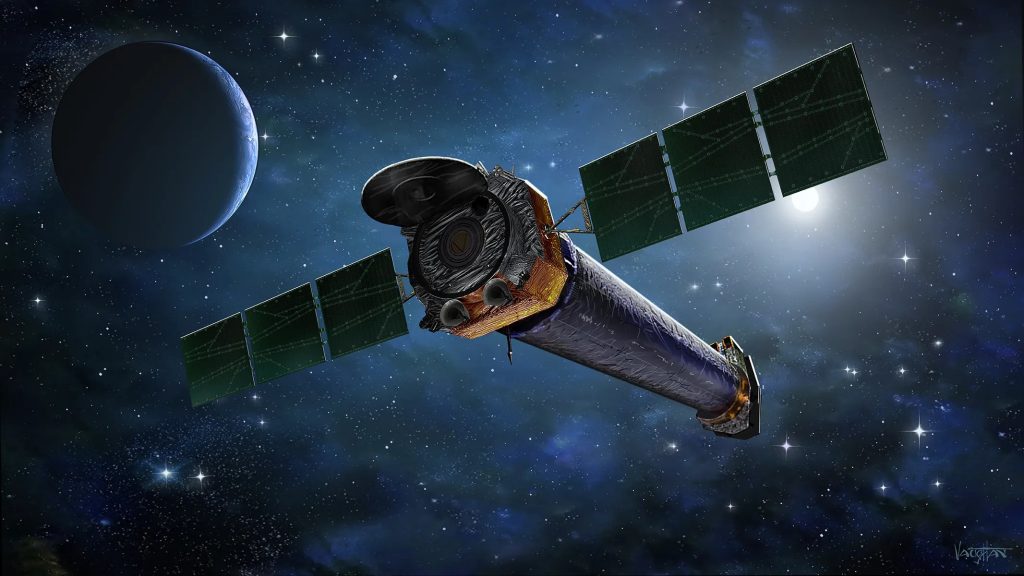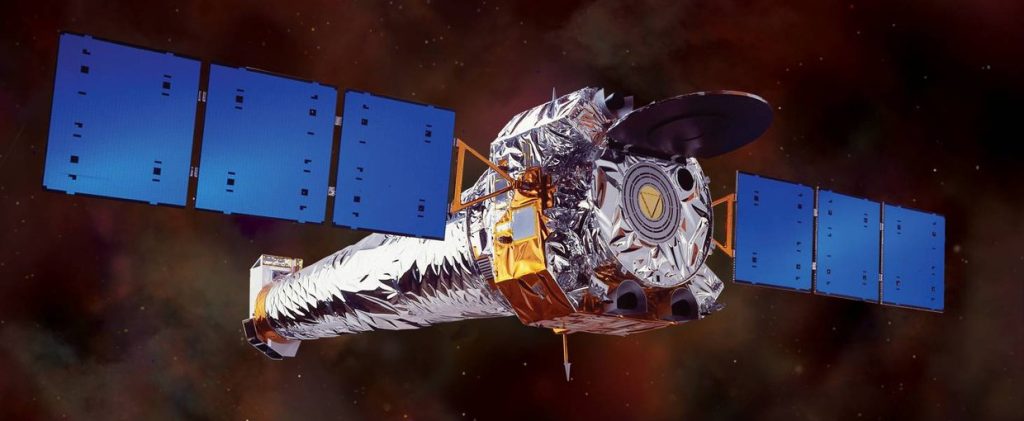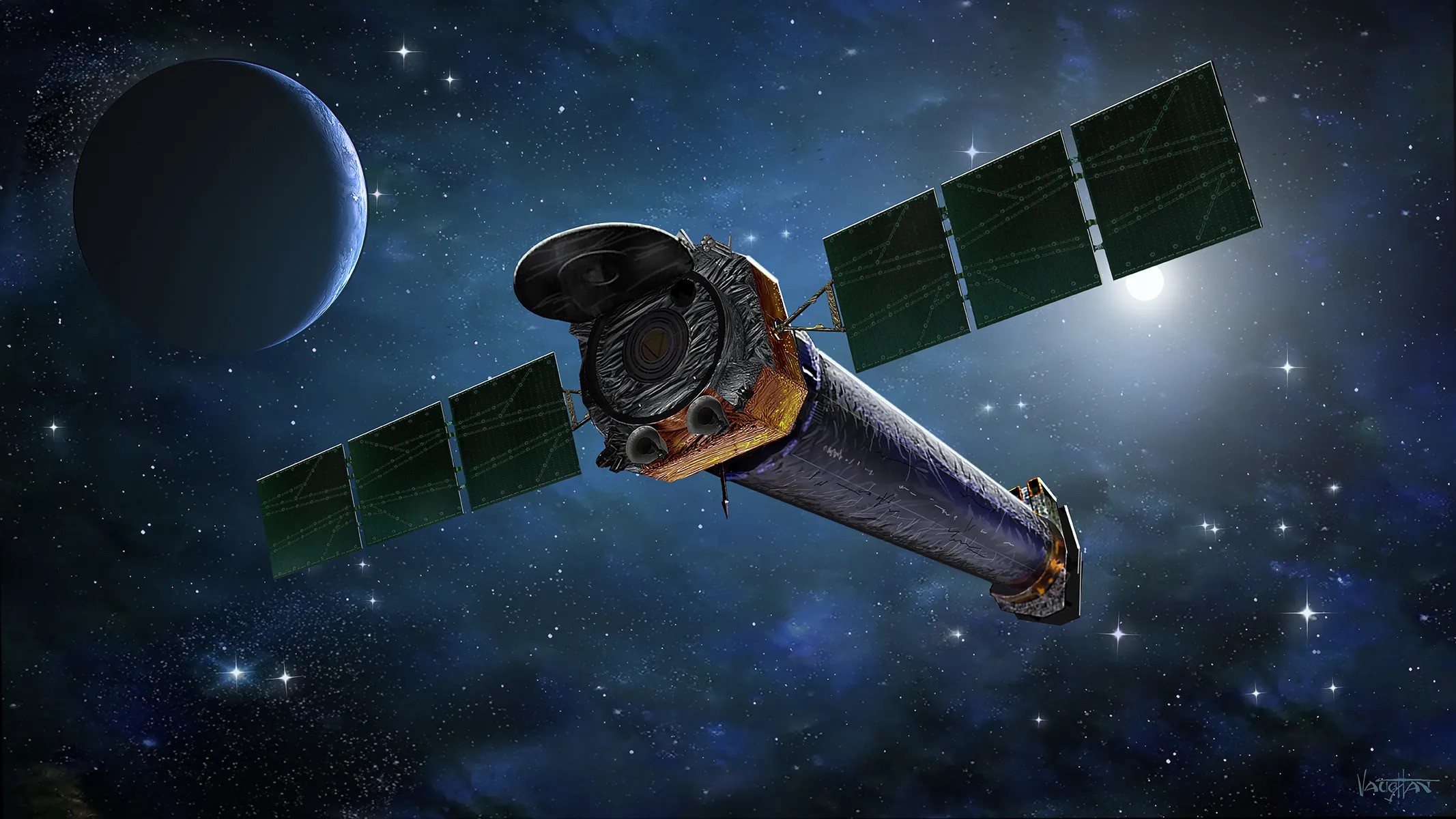Gazing into the vacuum of space, what vistas await discovery through cutting-edge lenses? Giving eyes to peer farther and sharper than ever before, the Chandra X-Ray Observatory embodies the pinnacle of astronomical vision.
From its unique vantage point, Chandra unveils secrets of high-energy light spiraling from exotic realms of stars, black holes, and beyond.
As the premier space telescope providing a view into the hottest, most violent events in the Universe, there are still many discoveries to be made through the observing capabilities of the Chandra X-ray telescope.
In this article, we will understand how Chandra provides insights into cosmic mysteries, guiding the development of cutting-edge astrophysical theories.
What Is the Chandra X-Ray Observatory?
The Chandra X-ray Observatory (CXO) is a space-based telescope designed to observe X-rays from high-energy regions of the universe.
Launched by NASA in 1999, Chandra plays a crucial role in astrophysics. It allows scientists to study phenomena such as black holes, supernova remnants, and galaxy clusters emitting X-ray radiation.
As one of NASA’s Great Observatories, it has transformed scientific understanding of high-energy processes in space. The data from Chandra has unveiled previously hidden facets of the cosmos.
When it comes to Chandra X-Ray Observatory location, it is positioned in a highly elliptical orbit. Chandra avoids Earth’s radiation and captures detailed X-ray images, contributing significantly to our understanding of the dynamic and extreme environments in the cosmos.
After over two decades of observing even the faintest radiation from cosmic sources, Chandra’s unique vantage point has unveiled discoveries within distant galaxies as well as between interacting galaxy systems.
Its advanced capabilities provide unparalleled insights into the hot and energetic aspects of celestial objects, complementing observations made by other telescopes operating in different wavelengths.

Historical Development of Chandra
In the 1970s, astronomers wanted a telescope to see high-energy X-rays from hot gasses. This led to the concept of an advanced X-ray observatory. Early studies and workshops explored this idea further.
In 1976, the first high-energy observatory was launched by NASA. It was called HEAO-1. This demonstrated the value of X-ray astronomy from space. After many design studies, the Chandra X-ray telescope was approved in 1992.
It was first named the Advanced X-ray Astrophysics Facility (AXAF). Many new technologies were critical for Chandra, like high-resolution mirrors and detectors. It also required fast computing for high data rates.
Building and testing it took many years. Finally, In July 1999, the Space Shuttle launched the Chandra X-Ray Observatory successfully.
Composition and Design of Chandra
Key components
Chandra has several main parts. It has a High-Resolution Mirror Assembly with four nested mirrors. These collect X-ray photons efficiently. Chandra also has two focal plane cameras and two spectrometers.
One CCD camera takes images, the other makes spectra from dispersed light. These sit near the telescope focus. Chandra also has a control system for positioning and stability. Solar panels provide Chandra with the electrical power that it needs to operate.
Architectural design
Chandra X-Ray Observatory images are of high angular resolution. Its mirrors are shaped and aligned precisely to reflect X-rays to an accurate focus. Correcting for distortions was critical. Chandra also needs high-aiming stability for long exposures.
So, it has gyroscopes for precision pointing and control. To make sharp X-ray images, Chandra orbits far above the Earth’s atmosphere. This also gives an unobstructed view for long periods of observation. The distance also keeps its instruments very cold, as needed for detecting X-rays.Operational Mechanisms of Chandra
Scientific instruments
Chandra carries four science instruments. These advanced instruments allow for exploring extreme X-ray sources:
- ACIS detector – makes high-resolution images
- The HETG spectrometer – disperses X-ray energy for detailed source composition
- LETG spectrometer – measures continuum spectra
- HRC – a microchannel plate camera for timing studies
Data collection methods
To observe things, Chandra points quickly and precisely at targets. Its mirrors collect faint X-ray photons, which hit detectors at the focus. Detectors convert each X-ray into electric signals for processing.
Onboard computers turn raw data into science products like images, graphs, and tables. Data is downloaded regularly to analysis teams on Earth. Instead of pictures, Chandra data represent energy, wavelength, or emission time patterns. Analyzing that reveals the properties of the sources emitting the X-rays.
Superior Sensitivity Compared to Other Telescopes
Chandra detects fainter sources than older telescopes like Einstein and ROSAT. It sees over 10 times more discrete X-ray sources than previous missions. Its mirrors focus X-rays better as well. This concentration makes dim sources more detectable.
Also, Chandra’s solar orbit gets higher clarity. With no atmosphere obscuring views, space observations access more X-rays. On the ground, our dense atmosphere absorbs most cosmic X-rays. Only high-energy gamma rays can penetrate land-based instruments.
Compared even to other Great Observatories like Hubble and Compton, Chandra uniquely covers higher-energy realms. So it reveals extreme physics around black holes, exploded stars, and stellar nurseries that other telescopes cannot probe.

Advanced Techniques and Capabilities
Grazing angle reflection
Chandra’s mirrors use grazing angles for X-ray reflection. Light approaches the mirrors very shallowly. Like skipping stones across the water. This lets X-rays reflect, which normally pass through surfaces. The grazing angles concentrate diffuse X-ray light more densely for higher-resolution imaging.
Imaging X-ray light
Chandra makes high-resolution X-ray maps instead of pictures. It can see tiny differences in light across various parts of space. It uses a computer to turn those differences into maps that show how bright the X-rays are. The colors on the maps represent the varying levels of brightness.
Chandra’s advanced imaging reveals clouds and structures in X-ray gases. It also tracks changes in X-ray brightness over time. By watching these fluctuations, we can map out the behaviors around extreme objects in space.
Launch and Deployment of Chandra
Launch process
Chandra was too big for normal rockets. So NASA decided to use the Space Shuttle. This allowed assembling it in space. In July 1999, the shuttle Columbia carried Chandra into orbit. This was complex, with no room for error.
Chandra was the largest satellite Columbia had ever deployed. The shuttle and observatory orbited together first. Then, the shuttle crew released Chandra slowly and carefully.
Deployment in space
After release from Columbia, Chandra fired rockets to reach higher orbit. Chandra unfurled its solar panels, too. Next, it deployed its instruments and mirrors safely. Ground control then activated components and systems one by one. This took two weeks.
Finally, focus and aim calibration lasted months. By the start of 2000, Chandra could make its first X-ray astronomical observations.
Role of Key Institutions
Chandra X-ray center
The Chandra X-ray Center operates the telescope. It plans observations and processes data. It also archives data products for astronomers. The center chooses to observe targets based on proposals, and it issues calls for new proposals annually.
The center has science teams to help users analyze findings. It also handles public outreach about Chandra’s discoveries.
Advanced X-ray astrophysics facility
The Advanced X-Ray Astrophysics Facility was the initial program developing Chandra. It coordinated design, technology development, and assembly.
The program demonstrated key innovations needed for X-ray astronomy from space. These included sub-arcsecond resolution optics, efficient X-ray detectors, and large throughput data systems.
The program also managed launch and orbital insertion before transitioning operations to the Chandra X-ray Center. Its investments and management were critical to enabling Chandra’s high-sensitivity X-ray vision.
Conclusion
With over two decades of unprecedented insights into high-energy realms of our Universe, the Chandra space telescope has revolutionized our comprehension of hidden processes and structures.
Chandra employs advanced technologies such as grazing angle reflection, providing a new X-ray vision. It breaks through the imaging barriers of extreme environments within exploded stars, stellar nurseries, and galaxies. In doing so, Chandra uncovers an exotic Universe that remains invisible in other wavelengths.
As the powerful space telescope ushers a deeper understanding of the origin and evolution of black holes, novas, supernova remnants, and more, the Chandra X-Ray Observatory will keep unsealing cosmic mysteries for years further still.
This article has illuminated the astonishing capabilities, mission, and discoveries of this unique space observatory. We hope you have gained a new appreciation for the Great Observatory’s pivotal impacts in advancing the frontiers of astronomical knowledge.

